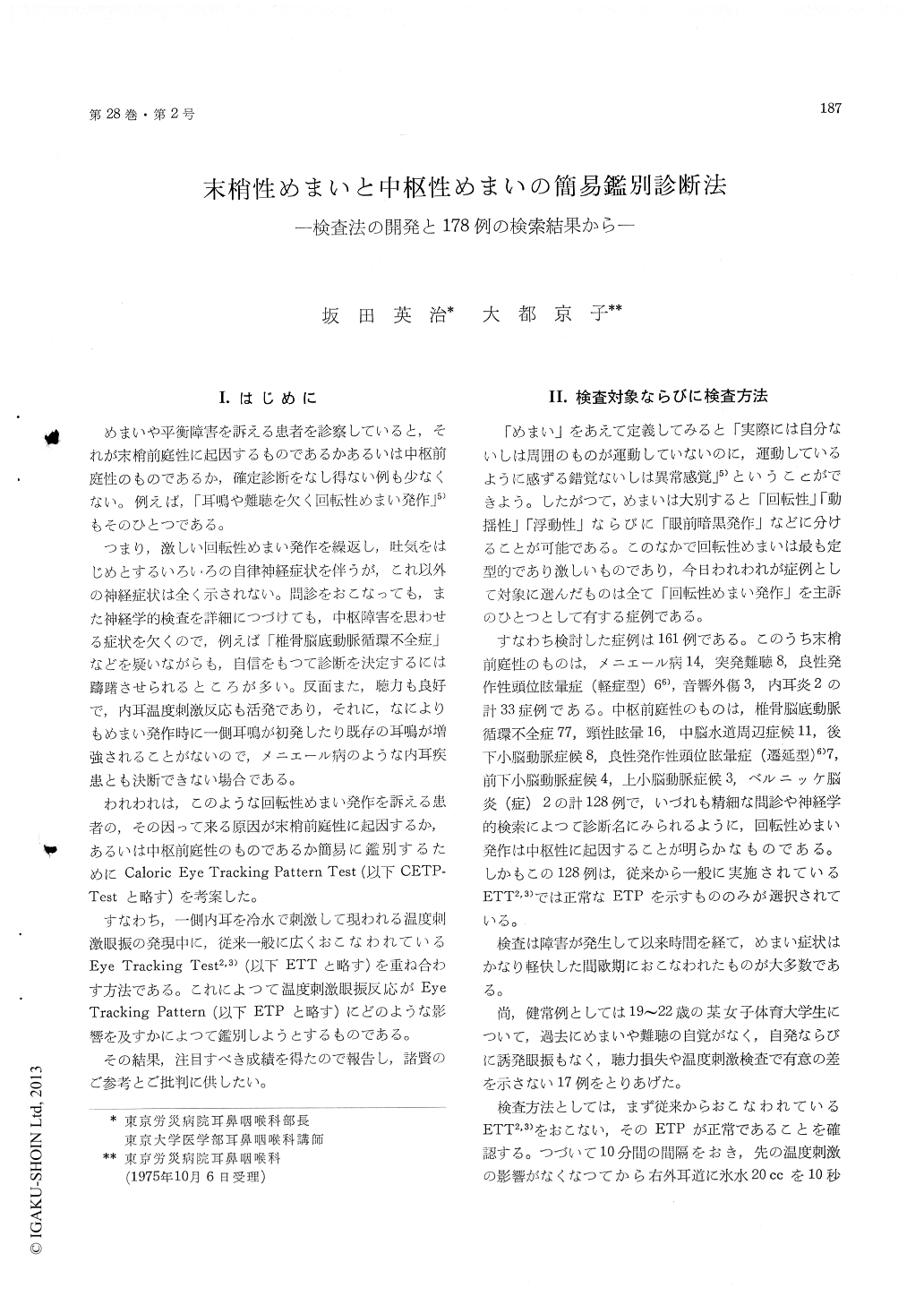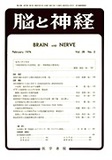Japanese
English
- 有料閲覧
- Abstract 文献概要
- 1ページ目 Look Inside
I.はじめに
めまいや平衡障害を訴える患者を診察していると,それが末梢前庭性に起因するものであるかあるいは中枢前庭性のものであるか,確定診断をなし得ない例も少なくない。例えば,「耳鳴や難聴を欠く回転性めまい発作」5)もそのひとつである。
つまり,激しい回転性めまい発作を繰返し,吐気をはじめとするいろいろの自律神経症状を伴うが,これ以外の神経症状は全く示されない。問診をおこなっても,また神経学的検査を詳細につづけても,中枢障害を思わせる症状を欠くので,例えば「椎骨脳底動脈循環不全症」などを疑いながらも,自信をもつて診断を決定するには躊躇させられるところが多い。反面また,聴力も良好で,内耳温度刺激反応も活発であり,それに,なによりもめまい発作時に一側耳鳴が初発したり既存の耳鳴が増強されることがないので,メニェール病のような内耳疾患とも決断できない場合である。
In patients who complain of vertigo or who haveequilibrium disorders, it is often difficult to de-termine the etiology of the disorder, that is to de-termine whether it is dependent on a peripheralor central vestibular disorder. To attempt to de-termine the etiology in these cases, we divised anew method, the caloric eye tracking pattern test(CETP-Test).
Seventeen normal subjects and 161 patients weretested. The latter group included 33 with peripheraldisorders such as Meniere's disease, benign paroxy-smal positional nystagmus, and others, and 128 withcentral disorders such as vertebral basilar arteryinsufficiency, cervical vertigo, and others, weretested. The cases of central disorders were limitedto those patients whose eye tracking pattern beforethe caloric stimulation was normal.
In normal subjects and in patients with peripheraldisorders, it is well known that caloric nystagmushas little influence on the eye tracking pattern.In contrast, in patients with central vestibular dis-orders, caloric nystagmus evokes abnormalities onthe eye tracking pattern, either superimposed orsaccades, despite the fact that the eye trackingpattern before the caloric stimulation is normal.
First we administer the eye tracking test usinga target which moves horizontally at 0.3 cycle persecond. Next, we perform the caloric test on theright ear, using 20c. c. of ice water for 10 seconds.During the evoked caloric nystagmus we administerthe eye tracking test once again. The eye trackingpattern is recorded for 20 seconds beginning 50seconds after the start of the ice water injection.The procedure repeated on the left ear. The resultson each case are presented as three patterns ofENG-recording.
We may state that in normal subjects and inpatients with peripheral vestibular disorders, visualsuppression of caloric nystagmus remains functional.Caloric induced nystagmus does not affect theCETP. In patients with central vestibular disorders,visual suppression of caloric nystagmus does notfunction properly because of defects in the visualsuppression mechanism. Therefore, caloric nystag-mus greatly influences the CETP. Consequently,the CETP may not be smooth when CETP test isadministered to patients with central vestibulardisorders. We may say also that the visual sup-pression to the vestibular nystagmus is evokedmore strongly by pursuing a moving visual stimulusthan by gazing a stational target.
These results allow for a differential diagnosisbetween peripheral and central disorders.

Copyright © 1976, Igaku-Shoin Ltd. All rights reserved.


